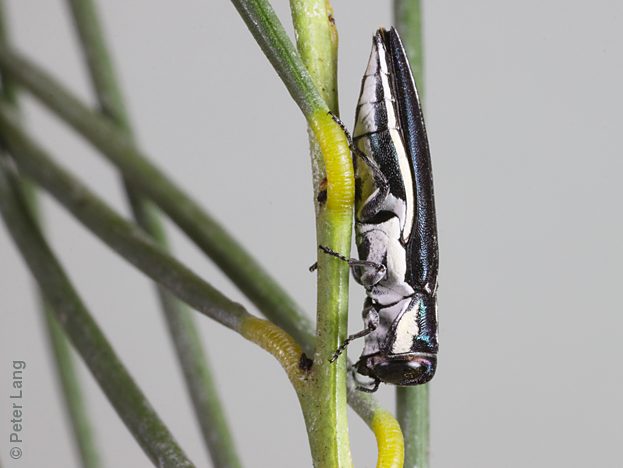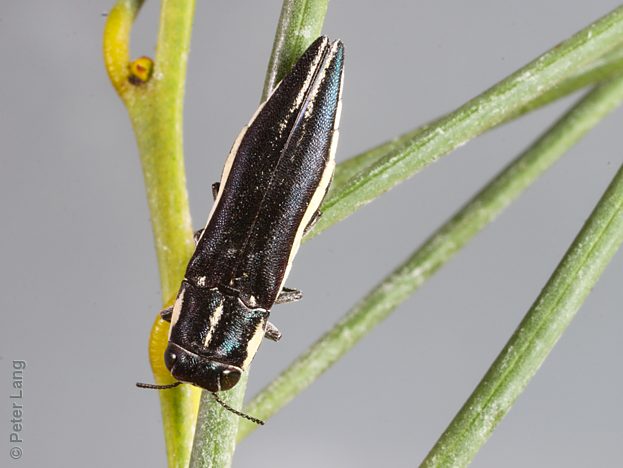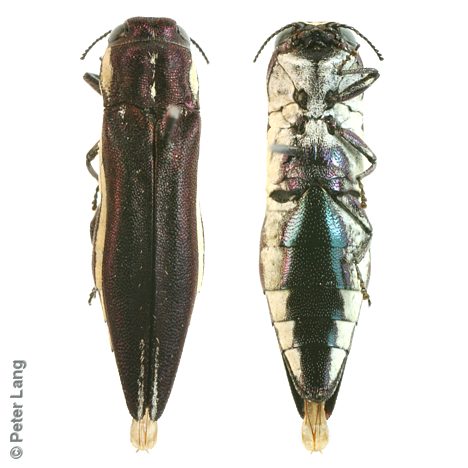


size¹:
×
2.7 mm



| male | female | |||||
|---|---|---|---|---|---|---|
| L1 | 9.3 | 8.45 – 10.4 | n = 7 | 10.0 | 8.05 – 11.65 | n = 11 |
| L2 | 9.2 | 8.3 – 10.2 | n = 7 | 9.8 | 7.95 – 11.5 | n = 5 |
| W | 2.5 | 2.25 – 2.7 | n = 7 | 2.8 | 2.1 – 3.3 | n = 11 |
| Legend | L1 | length from clypeus/frons to elytral apex (mean, range, sample size) |
| L2 | length from anterior of edge of eyes to elytral apex | |
| W | maximum width with elytra fully closed |
Very similar to A. hypoleucus and its aedeagus is identical. Differs primarily in the shorter metatarsomeres (in males the first segment of the hind tarsus ('foot') is only about as long the next two segments combined) and in its usually more robust overall form.
Agrilus assimilis tends to occur in dryer areas than A. hypoleucus. There is evidence that it intergrades with A. hypoleucus. Some earlier museum collections that have been identified as A. hypoleucus are probably A. assimilis.
The type is from WA. Curletti 2001 placed a number of species in synonymy under this taxon including A. purpuratus (Syntype from Morialta, as 'Moriatta') described by Hope 1846b in the same paper as A. assimilis.
Turner 2001b noted the absence of specimens and records from the well-collected Sydney and eastern coastal areas and suggested that the species does not extend eastwards beyond the drier western side of the Great Dividing Range.
| Legend | P.J.Lang collection vouchered records | |
| other private collection or museum specimens, or sightings |
|
|
|
|
|
|
|
|
|
|
|
|
|
||||||||||||||||||||||||||||||||||||||||||||||||
|
|
|
|
|
|
|
|
|
|
|
|
|
||||||||||||||||||||||||||||||||||||||||||||||||
| Jul | Aug | Sep | Oct | Nov | Dec | Jan | Feb | Mar | Apr | May | Jun |
| Legend | live emerged adults, count > median value of 3 per quarter month | |
| live emerged adults, count <= median value of 3 | ||
| live non-emerged adults only, for that quarter month | ||
12 | number of active beetles for that quarter month |
| beetles | sites | SA regions¹ | family | position on host plant | ||
| Acacia calamifolia | 14 | 4 | FR | F | ||
| Acacia pycnantha | 9 | 2 | EP | F | ||
| Acacia nematophylla | 2 | 1 | YP | F | ||
| Acacia sp. | 2 | 1 | EP | F | ||
| Acacia euthycarpa | 1 | 1 | EP | F | ||
| Acacia hakeoides | 1 | 1 | EP | F |
| Legend | beetles | count of beetles collected from, or sighted on, host plant taxon |
| sites | count of major sites (unique 10 km grid cells +/- some distinct approximate localities) | |
| Plant names in green are hyperlinked to a matching host species page with plant photos. | ||
| Code | beetles | % | host plant taxa | |
| F | Fabaceae | 29 | 100% | 5 |
| position | beetles | sites | |
| on foliage or non-flowering plant | 29 | 10 |
Like Agrilus hypoleucus, this species probably feeds mainly on Acacia foliage. Curletti 2001 reported it being collected from Acacia ligulata, A. pycnantha and Eucalyptus fasciculosa.
| ¹ Legend | regions | SA State Herbarium regions (map) EA: Eastern, EP: Eyre Peninsula, FR: Flinders Ranges, GT: Gairdner-Torrens, KI: Kangaroo Island, LE: Lake Eyre, MU: Murray, NL: Northern Lofty, NU: Nullarbor, NW: North-Western, SE: South-Eastern, SL: Southern Lofty, YP: Yorke Peninsula |
| size | The ellipse is the correct size when printed, indicative on a desktop screen, and likely to be wrong on a mobile device. |